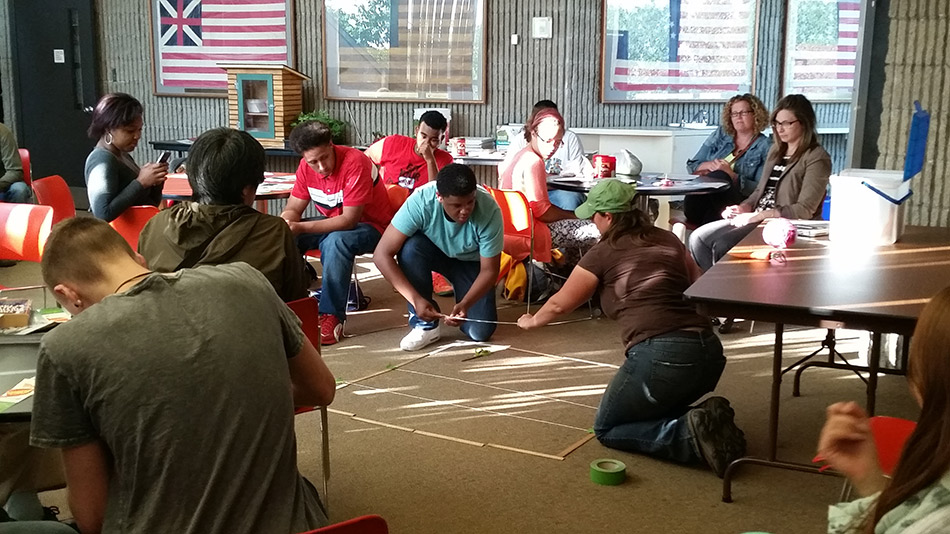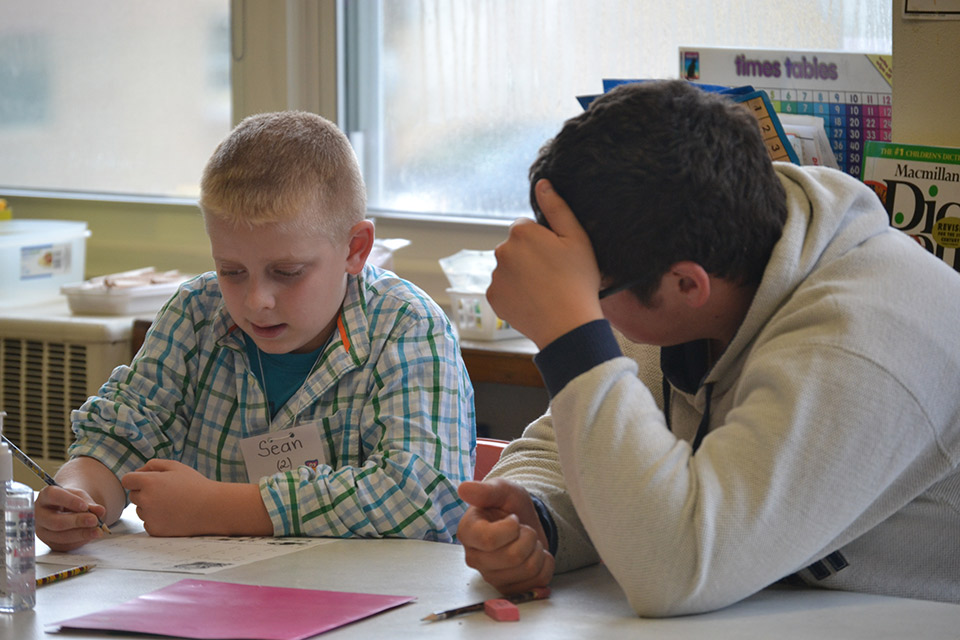IN THIS ISSUE:
Grantee Spotlight: Niagara University’s Levesque Center Channels Resources to the City of Niagara Falls
Continuing a Tradition of Engagement at Bowdoin College
Urban University Leaders Assess Community Partnerships
Grantee Spotlight: Niagara University’s Levesque Center Channels Resources to the City of Niagara Falls

Greenprint Niagara, one of ReNU Niagara’s programs, promotes the creative use of vacant lots in the city through gardening workshops and other activities. Credit: Tom Lowe
In 2000, David Taylor answered the call from Reverend Joseph L. Levesque, then the president of Niagara University, to develop a committee to revitalize the city of Niagara Falls, New York. Niagara Falls, like many other Rust Belt towns, had long been plagued by un- and underemployment and population loss. The committee’s early activities were humble but meaningful, says Taylor, who at the time was an assistant professor of criminology and criminal justice. Those activities complemented Niagara University’s other community-oriented development work, aligning with the school’s Vincentian mission to promote educational excellence, support social justice efforts, and help the poor. Within a dozen years, the ad hoc group had evolved into the Reverend Joseph L. Levesque, C.M. Institute for Civic Engagement, which collaborates with dozens of nonprofit, faith-based, and other social service providers to improve the quality of life for all Niagara Falls residents.
Becoming the Levesque Institute
In 2005, armed with a $400,000, 3-year Community Outreach Partnership Centers (COPC) grant from HUD and additional funds from the university, the revitalization committee hired a director and administrative staff and took on larger projects. One of these projects focused on workforce development. The committee sought to strengthen the city’s soft economy and declining job base, which left a quarter of the city’s population of 50,000 living below the poverty level in the wake of the recession.
When the COPC grant ended, the university folded the workforce development program into its operations and budget, renaming it ReNU Niagara. Three years later, Taylor proposed creating the Institute for Civic Engagement to, as he says, “put a structure around our work in the community and to ensure its long-term sustainability.” The university agreed and appointed Taylor the institute’s director. Renamed two years later when the university president retired, the Levesque Institute oversees four major initiatives, including ReNU Niagara, its flagship program, and Learn & Serve Niagara, which coordinates volunteer and service-learning opportunities for the university’s 4,150 graduate and undergraduate students. The other two major initiatives are Border Community SERVICE, which trains residents in disaster preparedness, and the Western New York Service Learning Coalition, a group of regional colleges and universities that promote service learning. The institute also manages dozens of small-scale community programs.

Niagara University students participating in the Levesque Institute’s Learn & Serve Niagara program tutor elementary school students at the Francis Center. Credit: Niagara University
ReNU Niagara Today.
Niagara Falls has a number of excellent social services that respond to residents’ needs, says Tom Lowe, ReNU Niagara’s director. Rather than replicate those services, ReNU Niagara enacts preventative measures to reduce residents’ need for social services over time. An example of this proactive approach involves improving access to healthy food, which is a major concern in Niagara Falls; large swaths of the city are considered food deserts, and 15 percent of those receiving social services say that having “no money for food” is their greatest concern. ReNU Niagara addresses food insecurity by participating in the Create a Healthier Niagara Falls Collaborative, a nonprofit that promotes breastfeeding and provides fresh, nutritious food in schools and hospitals. ReNU Niagara also provides capacity-building assistance to local organizations. One such activity is grant writing for Isaiah 61, a faith-based group that offers free training in the construction trades. In addition, ReNU Niagara used a community development block grant from HUD to start the Greenprint Niagara program, which creatively adapts and reuses vacant lots as community gardens or other neighborhood assets.
Transforming Experience through Learn & Serve Niagara
The Levesque Institute’s Learn & Serve Niagara program, which provides the university community with volunteer and service-learning opportunities, has 30 faculty members who integrate their coursework with nonprofits or small businesses to give students real-world experience. Instructor Mitchell Alegre’s spring 2015 business class worked with the Francis Center, a nonprofit sponsored by the Sisters of St. Francis that provides services to low-income elementary school students. As part of their coursework, the business students provided the Francis Center with fundraising and grant writing assistance. They also collected data on similar programs in Niagara County to create strategic plans for obtaining larger grants in the future.
An average of six education, business, and social work students staff the Francis Center’s afterschool program each day. This hands-on learning benefits the university students as well as the children in the afterschool program, says Sister Betty Neumeister, the center’s director. The Niagara University students benefit from applied experience in the classroom — each is paired with a veteran teacher — while also learning about the children’s experiences with poverty, abuse, and other needs. Taylor says, “Service learning is part of our DNA at Niagara. And service learning — connecting the classroom to the community — can really transform students’ lives.” As for the elementary school children, they “love to work with these students,” says Neumeister; they thrive on the one-on-one attention.
Collaborating with Other Groups, Large and Small
The Levesque Institute works with institutions throughout the region in its other two major initiatives. Border Community SERVICE trains residents in disaster preparedness and works with civic groups such as the Boy and Girl Scouts as well as local elementary schools to prepare young people for emergencies. The university also hosts the Western New York Service Learning Coalition, an informal collaborative of 10 regional higher education institutions that range from small, faith-based schools such as Daemen College to large research centers such as the University at Buffalo. The coalition institutions pool resources, hold an annual conference, and share best practices for enacting service learning.
The institute is also heavily involved in 50 other projects that provide opportunities for collaboration with local nonprofits. Among these is the Experience College program, initiated in 2009, which brings elementary and high school students to the campus to expose them to university life. “Kids come from homes and neighborhoods where college isn’t on the radar screen,” Taylor says. “They don’t think about it as a possibility for themselves.” The Experience College program introduces students to the school’s art museum and the men’s basketball team, and a business professor teaches students about the stock market using a game of Monopoly. Through these small-scale programs and major initiatives, the Levesque Institute directs resources where they can best improve life in the community, and Niagara University fulfills its educational and faith-based missions.
Source:
Interview with David Taylor, director, Levesque Institute, 22 December 2015; Correspondence from David Taylor, 20 January 2016; Niagara University. 2016. “Mission Statement.” Accessed 14 January 2016; Levesque Institute. 2016. “Service Highlights.” Accessed 29 January 2016.
×Source:
Niagara University n.d. “Community Outreach Partnership Center: Niagara University Awarded Grant to Establish Highland Greenfields Project.” Accessed 14 January 2016; U.S. Department of Housing and Urban Development, Office of University Partnerships. n.d. “Grantee Database.” Accessed 28 January 2016; Interview with David Taylor, director, Levesque Institute, 22 December 2015; Interview with Tom Lowe, director, ReNU Niagara, 17 December 2015; U.S. Census Bureau. 2015. “QuickFacts: Niagara Falls (city), New York.” Accessed 18 January 2016.
×Source:
Interview with David Taylor, 22 December 2015; Levesque Institute. 2016. “Programs.” Accessed 18 January 2016; Correspondence from David Taylor, 20 January 2016; Niagara University. 2016. “Overview.” Accessed 29 January 2016.
×Source:
Correspondence from Tom Lowe, 14 January 2016; University at Buffalo Regional Institute. 2013. “Strengthening WNY’s Safety Net.” Accessed 18 January 2016; Interview with Tom Lowe, 17 December 2015.
×Source:
Interview with David Taylor, 22 December 2015; Interview with Sister Betty Neumeister, director, Francis Center, 4 January 2016; Correspondence from Sister Betty Neumeister, 14 January 2016.
×Source:
Correspondence from Sister Betty Neumeister, 14 January 2016; Interview with Sister Betty Neumeister, 4 January 2016; Interview with David Taylor, 22 December 2015.
×Source:
Levesque Institute. 2016. “Emergency Preparedness Workshop for WNY Scouts,” Border Community SERVICE (January), 1. Accessed 10 January 2016.
×Source:
Interview with David Taylor, 22 December 2015. ×

